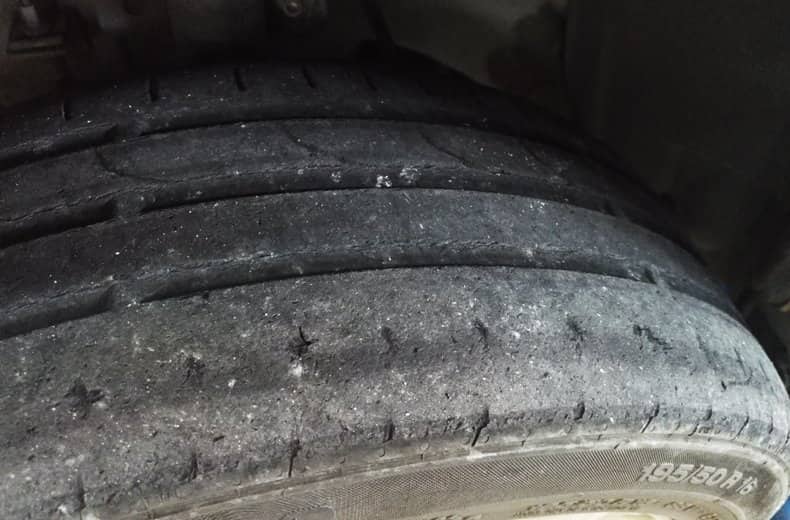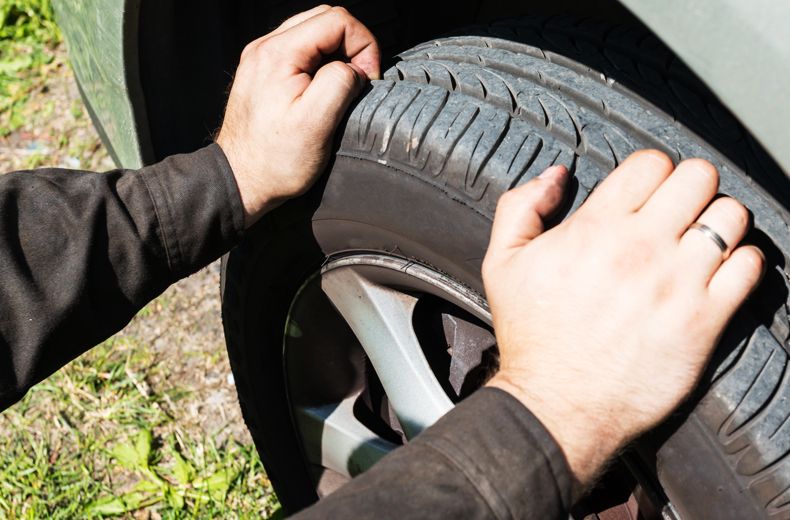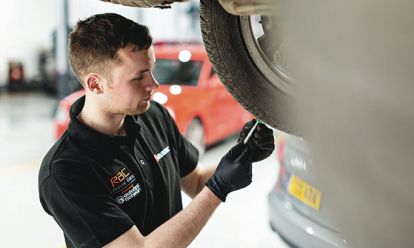With a range of things to consider we have developed this guide of need-to-know tyre maintenance information to ensure you get the best performance and value for money out of your rubber.
It's also well worth reading our guide to tyre safety too if you haven't already.
How long do tyres last?
Miles wise, you should be able to get at least 20,000 miles out of your front tyres and 40,000 for your back tyres. However, this depends on a few factors, chiefly:
- The quality of the tyre itself
- The road conditions it's used on
- How well it’s looked after (both from a maintenance and careful driving perspective)
There’s a useful rule of thumb to bear in mind.
Tyre experts Michelin recommend that, after five years or more on your vehicle tyres should be inspected at least once a year by a professional. Then, if they’re still on your car ten years after they were manufactured then they should be replaced anyway, as a precaution.
Are expensive tyres worth the cost?
The difference between the most expensive tyres and budget range tyres can amount to several hundred pounds, especially if you need a full set fitting. Yet are the priciest options worth the extra cash?
Once again, this depends on how much you drive, where you drive and how well you look after your tyres.
If you have a high mileage and drive on a lot of high speed roads such as motorways then you might well benefit from the added grip and performance of a premium tyre.
Mid range brands are a good compromise for those with a more modest mileage, while budget brands are probably fine for runarounds.
People who drive a lot, use motorways often and are prepared to look after their cars might well get good value from investing in the more expensive tyres on the market. Check out our guide to tyre buying for more information on selecting the right tyres for your vehicle.
Should I use winter tyres?
It’s mandatory in some European countries, where more extreme weather is common, to switch to winter tyres. This isn’t the case in the UK but, for those living in remote rural areas that could be cut off by snow or ice, they might be a prudent investment to protect your standard tyres for the remainder of the year.
Winter tyres are made of a softer rubber compound and have little slits on the tread to maximise traction when passing over snow and ice.
Once the temperatures go above 7C winter tyres offer a poorer performance, with increased braking distances and poorer performance on bends.
For a full break down of whether winter tyres are right for you, read our winter tyres pros and cons guide.
How to get more out of your tyres
No matter whether you opt for budget, mid range or premium tyres, it’s vital to look after them properly so that you can get the maximum levels of performance and safety from your vehicle. Here are the factors that you need to consider if you are to get more from your tyres:
Inflation
If your tyres are under-inflated then their ‘rolling resistance’ increases, which means that you need more fuel and energy to push your car along and therefore spend more money on petrol or diesel.
Under-inflated tyres are more likely to blowout, causing you to breakdown, while they can also reduce the performance when braking, cornering or accelerating – especially in wet conditions.
You can find out the pressure that your tyres should be inflated to by looking in your vehicle’s manual or by consulting the sticker placed on most vehicles, usually inside the door.
Check out our video for help on how to check your tyre pressure and make sure you do this on a regular basis, especially before long journeys.
Tread
Your tyres are the only contact between your vehicle and the road surface, so when they wear down you put this at risk.
It’s worth noting that it is also illegal to be driving with tyres that have a ‘tread’ below the legal limit. The punishment for this is £2,500 per tyre and three penalty points on your driving licence.
The tread of a tyre is the bit of rubber that actually makes contact with the road. The legal minimum depth for this rubber is 1.6mm across the central three-quarters of the tyre and it must meet this measurement all the way around the circumference. However, it’s worth noting that the performance of the tyre will deteriorate once this gets below 3mm.
See our article on checking tyre treads to learn how to do this for yourself and keep an eye on the state of your tyres.

Don't let your tyres get this worn down!
Balance
You might feel your tyres ‘wobble’ a little once you travel above 40 or 50mph and this – along with uneven wear and tear – can be a sign that your wheels need to be rebalanced. This can be fairly simply fixed fix by a tyre specialist and prevent further deterioration of your tyres.
Driving style
When it comes to your vehicle the upkeep is important but so too is the way that you drive. Avoiding driving too fast or heavy braking and abrupt cornering will be better for your tyres in the long run.
By making sure you are calm when behind the wheel and drive smoothly at all times you could prolong the shelf life of your tyres.
Rotation
Different wheels take a different burden when you are driving. As a result, it can pay to rotate your tyres between the front and the rear of your vehicle so that you get even wear and tear.
Some manufacturers recommend that this is done every year or 7,500 miles, depending on which is done first. If you’re not sure, consult a professional and see if you need to rotate your tyres.
Focus on all of these factors and you’ll be in a strong position to get more miles from your tyres and avoid driving a car that is either inefficient or unsafe.
Below are some of our member's FAQs.
How many miles should a set of car tyres last?
When it comes to hw many miles a set of tyres should last, a driver should be able to get at least 20,000 miles out of the front tyres and 40,000 for the back tyres.
However, there are a lot of other factors that could make this a lot shorter. These can include driving style, weather conditions, road conditions and the quality of the tyre.
How long should front tyres last?
Front tyres in a modern vehcile should last up to 20,000 miles - but this can be shorter if you drive aggressively, or on poor road conditions.
What impacts tyre lifespan?
When it comes to a tyre's lifespan, there are several factors that can impact this.
Age
The age of a tyre significantly impacts its lifespan and safety. Even if it appears to have plenty of tread remaining, its rubber compounds degrade over time due to factors like UV exposure, heat, and general wear and tear.
As tyres age, the rubber becomes harder and more brittle, losing its flexibility and grip - two key parts of a safe tyre.
Over time, tyres may develop cracks in the sidewalls due to the natural aging process. This will weaken the tyre, increasing the risk of failure.
Also, most tyre manufacturers recommend replacing tyres every few years. Some high-performance or specialty tyres may have a shorter lifespan.
Interestingly, tyres stored in a cool, dry place and are well-maintained, will likely last longer than those exposed to harsh weather or left in poor conditions.
Wear and tear
Wear and tear on tyres is common, as the gradual deterioration of the tread and rubber happen due to regular use.
This can be caused by factors such as driving habits, road conditions, tyre pressure, and vehicle alignment - as well as a variety of other car maintenance factoes.
As the tread wears down, the tyre loses its ability to grip the road effectively, increasing the risk of accidents, especially in wet conditions.
What is the average tyre lifespan?
The lifespan of front tyres is typically around 20,000 miles, while rear tyres can last up to 40,000 miles.
However, this depends on factors like tyre quality, road conditions, and how well the tyres are maintained and cared for.
When to replace tyres on your car?
You should replace your car's tyres are balding, as shallow tread reduces grip, especially in wet conditions.
Additionally, replace tyres if they show visible signs of damage, such as cracks, bulges, or punctures that can’t be repaired.
If the tyres are over six years old, even with good tread, they may be compromised due to aging. Remember, that performance tyres need to be replaced sooner.
Finally, always replace tyres if they exhibit uneven wear or performance issues to maintain safety.

RAC sale – up to 33% off*
• Roadside cover from £5.29 a month†
• We get to most breakdowns in 60 mins or less
• Our patrols fix 4/5 breakdowns on the spot
















